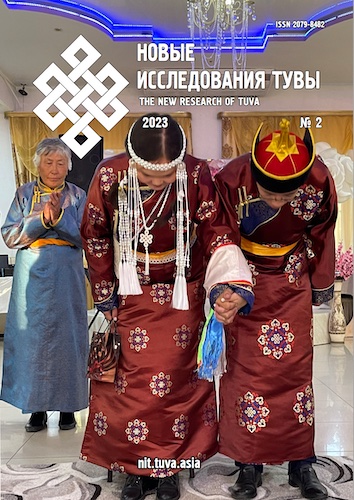Features of functioning and legal regulation of the labor market in the Republic of Tuva under conditions of the COVID-19 pandemic and digital transformation
DOI:
https://doi.org/10.25178/nit.2023.2.2Keywords:
Republic of Tuva; labor market; labor resources; employment; unemployment; labor migration; digital transformation; COVID-19 pandemicAbstract
The article presents an analysis of the impact of extraneous shocks (the pandemic and digitalization) on the conditions of the labor market in the Republic of Tuva and prospects for increasing its adaptability to the challenges of a changing economy.
The Republic has a complex economic structure and an unbalanced labor market. Along with the general underemployment and lack of employment opportunities for promising young people, there is a backlog demand for specialists who have the qualifications necessary for the Tuvan economy. The problem lies in the unresponsiveness of the Tuvan labor market to attempts to reverse negative trends. This complicates the transition of the Republic’s economy to an innovative development model.
We have analyzed new phenomena in the Tuvan labor market that are related to the pandemic and digital transformation processes. The authors have considered opportunities for improving regulatory measures aimed at coping with the imbalances of the republican labor market, primarily the structural lack of labor resources. The impact of the pandemic is defined as ambivalent: amid economic difficulties and social losses, the external shock has become one of the incentives to accelerate the digital transformation in various spheres of life and activity, including the systems of education, employment and the economy as a whole. An attempt is made to assess the impact of new factors that emerged in 2022 (the introduction of international sanctions and partial mobilization) on the Tuvan labor market and its regulation.
References
Abuzyarova, N. A. (2018) Ekonomiko-pravovoe regulirovanie rossiiskogo rynka truda [Economic-legal regulation of the Russian labor market]. Zhurnal rossiiskogo prava, no. 1 (253), pp. 128–137. (In Russ.). DOI: https://doi.org/10.12737/art_2018_1_11
Abylkalikov, S. I. (2021) Osobennosti demograficheskogo razvitiia Tuvy: vklad migratsii v demograficheskii balans [Features of the demographic development of Tuva: Contribution of migration to the demographic balance]. New Research of Tuva, no. 4, pp. 131–142. (In Russ.). DOI: https://doi.org/10.25178/nit.2021.4.10
Auzan, A. A. (2015) «Effekt kolei». Problema zavisimosti ot traektorii predshestvuiushchego razvitiia — evoliutsiia gipotez [“The rut effect”. Path dependence problem: The evolution of approaches]. Vestnik Moskovskogo universiteta. Series 6: Ekonomika, no. 1, pp. 3–17. (In Russ.).
Auzan, A. A. (2017) Razvitie i «koleia» zavisimosti [Path dependence problem and possibilities of its overcoming]. World Eсonomy and International Relations, vol. 61, no. 10, pp. 96–105. (In Russ.). DOI: https://doi.org/10.20542/0131-2227-2017-61-10-96-105
Akhmetova, G. F. (2022) Migratsionnye protsessy v natsional’nykh respublikakh s raznym urovnem razvitiia chelovecheskogo potentsiala (na primere Bashkortostana, Tatarstana i Tuvy) [Migration processes in national republics with different levels of human development: The cases of Bashkortostan, Tatarstan and Tuva]. New Research of Tuva, no. 2, pp. 53–69. (In Russ.). DOI: https://doi.org/10.25178/nit.2022.2.4
Badmaeva, N. V. and Natsak, O. D. (2021) Sovremennaia trudovaia migratsiia iz Kalmykii i Tuvy: ekonomicheskie, sotsiokul’turnye i gendernye aspekty [Modern labor migration from Kalmykia and Tuva: Economic, socio-cultural and gender aspects]. New Research of Tuva, no. 4, pp. 186–205. (In Russ.). DOI: https://doi.org/10.25178/nit.2021.4.14
Balakina, G. F. and Begzi, A. D. (2016) Ekonomika Tuvy: vozmozhnye strategii razvitiia [The economy of Tuva: Possible strategies of development]. Kyzyl, Tuvan Institute for Integrated Development of Natural Resources of the Siberian Branch of the RAS. 380 p. (In Russ.).
Veselova, E. Sh. (2018) «Eniseiskaia Sibir'» — pervyi makroregion Rossii [“Yenisei Siberia” — the first macroregion of Russia]. EKO, no. 6 (528), pp. 20–37. (In Russ.). DOI: https://doi.org/10.30680/ECO0131-7652-2018-6-20-37
Kashepov, A. V., Sulakshin, S. S. and Malchinov, A. S. (2008) Rynok truda: problemy i resheniia [Labor market: Problems and solutions]. Moscow, Nauchnyi ekspert. 232 p. (In Russ.).
Kylgyday, A. Ch. (2012) Rynok truda regiona: problemy formirovaniia i regulirovaniia (na primere Respubliki Tyva) [The labor market of the region: Problems of formation and regulation (the case of the Republic of Tuva)]. Regional'naia ekonomika: teoriia i praktika, no. 35, pp. 31–38. (In Russ.).
Kylgyday, A. Ch. (2020) Rol' traditsionnoi zaniatosti tuvintsev v reshenii problem rynka truda regiona: novye podkhody [Role of traditional employment of Tuvans in solving the labor market problems of the region: New approaches]. Ekonomika. Professiia. Biznes, no. 1, pp. 65–70. (In Russ.). DOI: https://doi.org/10.14258/epb201960
Kylgyday, A. Ch. (2022) Rynok truda: izmeneniia v sfere truda, vyzovy sovremennosti [Labor market: Changes in the labor sphere, modern challenges]. Ekonomika. Professiia. Biznes, no. 1, pp. 63–66. (In Russ.). DOI: https://doi.org/10.14258/epb202208
Kylgyday, A. Ch. and Soyan, Sh. Ch. (2022) O vozmozhnostiakh razvitiia Tyvy kak prigranichnogo regiona [Development opportunities of Tuva as a border region]. Ekonomika. Professiia. Biznes, no. 3, pp. 69–73. (In Russ.). DOI: https://doi.org/10.14258/epb202239
Kylgydai, A. Ch. and Oidup, T. M. (2015) Osobennosti trudovogo povedeniia naseleniia Respubliki Tyva [Features of labor behavior of the population of the Republic of Tuva]. Regional'naia ekonomika: teoriia i praktika, no. 43 (418), pp. 43–53. (In Russ.).
Mandyt, M. K. (2015) Istoriko-geograficheskie osobennosti formirovaniia tuvinskogo naroda [Historical and geographical features of formation of the Tuvan people]. Vestnik Buriatskogo gosudarstvennogo universiteta. Biologiia, geografiia, issue 4, pp. 253–257. (In Russ.).
Mandyt, M. K. and Gonchikov, Ts. D. (2015) Regional'nye osobennosti dinamiki chislennosti naseleniia Respubliki Tyva [Regional features of dynamics of population number in the Republic of Tuva]. Vestnik Buriatskogo gosudarstvennogo universiteta. Biologiia, geografiia, issue 4, pp. 248–252. (In Russ.).
Mongush, A. S.-O. (2021) Analiz sostoianiia rynka truda v Respublike Tyva [Analysis of the state of the labor market in the Republic of Tuva]. Zakon i pravo, no. 3, pp. 63–66. (In Russ.). DOI: https://doi.org/10.24412/2073-3313-2021-3-63-66
Mongush, S. P. (2018) Rynok truda respubliki na etape perekhoda k tekhnologicheskomu razvitiiu (na primere materialov Respubliki Tyva) [Labor market of the Republic at the stage of transition to technological development: Evidence from the statistical materials of the Tyva Republic]. Regional'naia ekonomika: teoriia i praktika, vol. 16, no. 4 (451), pp. 665–680. (In Russ.). DOI: https://doi.org/10.24891/re.16.4.665
Oydup, T. M. and Kylgyday, A. Ch. (2015) Vliianie bezrabotitsy na sotsial'no-ekonomicheskoe razvitie regiona (na primere Respubliki Tyva) [The impact of unemployment on the socio-economic development of the region (the case of the Republic of Tuva)]. EKO, no. 6 (492), pp. 131–138. (In Russ.).
Oydup, T. M. and Troshkina, I. N. (2022) Professional’nye predpochteniia vypusknikov shkol stolits respublik Tyva, Altaia i Khakasii kak osnova formirovaniia chelovecheskogo kapitala regionov (2021 g.) [Vocational choices of secondary school graduates in the capitals of Tuva, Altai and Khakassia as a basis of building human capital in the region (2021)]. New Research of Tuva, no. 2, pp. 198–210. (In Russ.). DOI: https://doi.org/10.25178/nit.2022.2.14
Polterovich, V. M. (2004) Institutsional'nye lovushki: est' li vykhod? [Institutional traps: Is there a way out?]. Obshchestvennye nauki i sovremennost', no. 3, pp. 5–16. (In Russ.).
Sevek, V. K., Badarchi, Kh. B., Sevek, R. M., Manchyk-Sat, Ch. S. and Chul'dum, A. E. (2016) Issledovanie stsenariia razvitiia Respubliki Tyva v sisteme territorii operezhaiushchego razvitiia [Study of the development scenario of the Republic of Tuva in the system of the territory of advanced development]. Ekonomika: vchera, segodnia, zavtra, no. 6, pp. 43–58. (In Russ.).
Soyan, Sh. Ch. and Mongush, Sh. V. (2021) Analiz vostrebovannosti vypusknikov na rynke truda Respubliki Tyva [Analysis of the need for graduates on the labor market of the Republic of Tyva]. Journal of Economy and Business, vol. 1–2 (71), pp. 125–127. (In Russ.). DOI: https://doi.org/10.24411/2411-0450-2021-10082
Erdynieva, L. S. (2003) Sostoianie zdorov'ia i demograficheskie protsessy naseleniia Respubliki Tyva [Health and demographic processes in the population of the Republic of Tyva]. Tomsk, STT. 158 p. (In Russ.).
David, P. A. (1985) Clio and the economics of QWERTY. The American Economic Review, vol. 75, no. 2, pp. 332–337.
Humphrey, C. and Sneath, D. (1999) The end of nomadism? Society, state and the environment in inner Asia. Durham, NC, Duke University Press. xi, 355 p.
Mongush, S. P., Avramchikova, N. T., Maslova, O. V. and Zakharova, L. N. (2020) Prospects of economic development of Republic Tyva project “Yenisei Siberia”. European Proceedings of Social and Behavioural Sciences, vol. 90, pp. 67–73. DOI: https://doi.org/10.15405/epsbs.2020.10.03.9
Vorobyev, N. V., Batomunkuev, V. S., Valeeva, O. V., Vorobyev, A. N., Gladkevich, G. I., Dagbaeva, S. D. N., Mikheeva, A. S., Osodoev, P. V., Permyakova, E. S., Sanzheev, E. D. and Sycheva, I. N. (2022) Socio-economic and demographic transformations of post-Soviet Siberia. In: Humans in the Siberian landscapes: Ethnocultural dynamics and interaction with nature and space / ed. by V. N. Bocharnikov and A. N. Steblyanskaya. Cham, Springer. xx, 538 p. Pp. 283–306. (Springer Geography). DOI: https://doi.org/10.1007/978-3-030-90061-8_13
Published
How to Cite
For citation:
Popova S. M., Yanik A. A. and Kashepov A. V. Osobennosti funktsionirovaniia i pravovogo regulirovaniia rynka truda Respubliki Tyva v usloviiakh pandemii COVID-19 i tsifrovoi transformatsii [Features of functioning and legal regulation of the labor market in the Republic of Tuva under conditions of the COVID-19 pandemic and digital transformation]. New Research of Tuva, 2023, no. 2, pp. 17-33 (In Russ.). DOI: https://doi.org/10.25178/nit.2023.2.2
Issue
Section

This work is licensed under a Creative Commons Attribution-NonCommercial 4.0 International License.

Author(s) license holder(s) grant rights for their work to the journal (grantee of a license) under the simple non-exclusive open license in accordance with Art. 1286.1 «Open license for a research work, work of literature or fine arts», Civil Code of the Russian Federation.
New Research of Tuva publishes articles under the Creative Commons Attribution-NonCommercial license (CC BY-NC).
Since it is an open license, author(s) reserve the right to upload the article to their institutional repository, submit it to another journal (if it allows republications), or republish it on their own website (in full, or in part).
However, several conditions apply here:
a) The republished version must always contain the name(s) and affiliation(s) of the author(s), the original title and the hyperlink to the original version on the New Research of Tuva website;
b) It must be in open access, free of charge, and no category of readers must be in any way whatsoever advantaged over general readership.
c) should the contribution be submitted elsewhere by its author(s) without substantial modification (30% or more of original text unchanged), the body of the article should contain a disclaimer that the original version was published in New Research of Tuva (with a link to the respective page)
The CC-BY-NC is a non-revocable license which applies worldwide and lasts for the duration of the work’s copyright.











